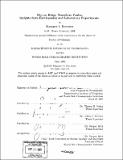Slip on ridge transform faults : insights from earthquakes and laboratory experiments
Author(s)
Boettcher, Margaret S
DownloadFull printable version (21.38Mb)
Alternative title
Slip on RTFs : insights from earthquakes and laboratory experiments
Other Contributors
Woods Hole Oceanographic Institution.
Advisor
Thomas H. Jordan, Jeffrey J. McGuire and Gregory Hirth.
Terms of use
Metadata
Show full item recordAbstract
The relatively simple tectonic environment of mid-ocean ridge transform fault (RTF) seismicity provides a unique opportunity for investigation of earthquake and faulting processes. We develop a scaling model that is complete in that all the seismic parameters are related to the RTF tectonic parameters. Laboratory work on the frictional stability of olivine aggregates shows that the depth extent of oceanic faulting is thermally controlled and limited by the 600⁰C isotherm. Slip on RTFs is primarily aseismic, only 15% of the tectonic offset is accommodated by earthquakes. Despite extensive fault areas, few large earthquakes occur on RTFs, and few aftershocks follow the large events. Standard models of seismicity, in which all earthquakes result from the same seismic triggering process, do not describe RTF earthquakes. Instead, large earthquakes appear to be preceded by an extended fault preparation process marked by abundant foreshocks within 1 hour and 15 km of the main- shocks. In our experiments normal force vibrations, such as seismic radiation from nearby earthquakes, can weaken and potentially destabilize steadily creeping faults. (cont.) Integrating the rheology, geology, and seismicity of RTFs, we develop a synoptic model to better understand the spatial distribution of fault strength and stability and provide insight into slip accommodation on RTFs.
Description
Thesis (Ph. D.)--Joint Program in Oceanography (Massachusetts Institute of Technology, Dept. of Earth, Atmospheric, and Planetary Sciences; and the Woods Hole Oceanographic Institution), 2005. Includes bibliographical references (p. 117-128).
Date issued
2005Department
Joint Program in Oceanography; Woods Hole Oceanographic Institution; Massachusetts Institute of Technology. Department of Earth, Atmospheric, and Planetary SciencesPublisher
Massachusetts Institute of Technology
Keywords
Joint Program in Oceanography., Earth, Atmospheric, and Planetary Sciences., Woods Hole Oceanographic Institution.